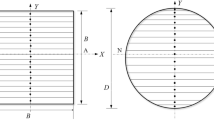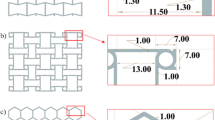Abstract
Nylon is a common engineering plastic that is easy to machine and can serve as a mechanical end-part. Ultrasonic testing is a highly efficient nondestructive testing method for the inspection of nylon materials. However, the curvature of the surface causes scattering or focusing of the ultrasonic beam bring difficulties to detect the inner defects. In addition, some configuration parameters, such as the water path depth, also affect the acoustic field distribution. It is necessary to predict the acoustic field distribution to achieve a better testing accuracy. An acoustic field simulation model based on a multi-Gaussian beam is established to predict the focused acoustic field in a multilayer medium under a curved interface. The relationship between the acoustic focusing area and the water path depth was explored, and the water path depth is selected by simulating the effective detection region. C-scan imaging of specimens with artificial flat-bottom holes are performed at different water path depths. By comparing the quantitative analysis results of different water path depths, the error of the FBH size obtained by selecting a water path depth is significantly less than others. The ultrasonic C-scan images of nylon bar with natural flaws are compared with the microscopic CT tomography reconstruction images, and the comparison shows that the defects can be detected in the C-scan images. The results show that the proposed method can optimize the configuration parameters to improve the accuracy of the flaw sizing. This study provides an efficient technique for the detection of nylon bars.













Similar content being viewed by others
Data Availability
Not applicable.
References
Zhang, Ye., Purssell, Chris, Mao, Ken, Leigh, Simon: A physical investigation of wear and thermal characteristics of 3D printed nylon spur gears. Tribol. Int. 141, 105953 (2020). https://doi.org/10.1016/j.triboint.2019.105953
Shakiba, M., Rezvani Ghomi, E., Khosravi, F., Jouybar, S., Bigham, A., Zare, M., Abdouss, M., Moaref, R., Nylon, R.S.: A material introduction and overview for biomedical applications. Polym. Adv. Technol. 32(9), 3368–3383 (2021). https://doi.org/10.1002/pat.5372
Pomarede, P., Meraghni, F., Peltier, L., Delalande, S., Declercq, N.F.: Damage evaluation in woven glass reinforced polyamide 6.6/6 composites using ultrasound phase-shift analysis and X-ray tomography. J. Nondestruct. Eval. 37(1), 1–21 (2018). https://doi.org/10.1007/s10921-018-0467-3
Fischlschweiger, M., Stock, A., Thurmeier, M.: Integrated defect classification in manufacturing of carbon fibre reinforced thermoplastic polymer matrix composites. Mater. Sci. Forum 879, 554–559 (2016). https://doi.org/10.4028/www.scientific.net/MSF.879.554
Im, K.H., Park, J.W., Yang, I.Y., Hsu, D.K.: Influence of electric field direction of terahertz radiation on composite materials. J. Compos. Mater. 54(12), 1603–1612 (2020). https://doi.org/10.1177/0021998316688592
Miqoi, N., Pomarede, P., Meraghni, F., Declercq, N.F., Guillaumat, L., Le, Coz G., Delalande, S.: Detection and evaluation of barely visible impact damage in woven glass fabric reinforced polyamide 6.6/6 composite using ultrasonic imaging, X-ray tomography and optical profilometry. Int. J. Damage Mech. 30(3), 323–348 (2021). https://doi.org/10.1177/1056789520957703
Yuan, S., Yu, X.: Ultrasonic non-destructive evaluation of selectively laser-sintered polymeric nanocomposites. Polym. Testing 90, 106705 (2020). https://doi.org/10.1016/j.polymertesting.2020.106705
Wen, J.J., Breazeale, M.A.: A diffraction beam field expressed as the superposition of Gaussian beams. J. Acoust. Soc. Am. 83(5), 1752–1756 (1988). https://doi.org/10.1121/1.396508
Huang, R., Schmerr, L.W., Jr., Sedov, A.: Multi-Gaussian ultrasonic beam modeling for multiple curved interfaces—an ABCD matrix approach. Res. Nondestr. Eval. 16(4), 143–174 (2005). https://doi.org/10.1080/09349840500306055
Zhang, S., Li, X., Jeong, H.: Analytical diffraction corrections for circular focused transducers expressed using the multi-Gaussian beam model. Acta Acust. Acust. 103(5), 717–720 (2017). https://doi.org/10.3813/AAA.919099
Kim, H.J., Schmerr, L.W., Jr., Sedov, A.: Generation of the basis sets for multi-Gaussian ultrasonic beam models—an overview. J. Acous. Soc. Am. 119(4), 1971–1978 (2006). https://doi.org/10.1121/1.2169921
Lu, Z., Xu, C., Xiao, D., Meng, F.: Nondestructive testing method for curved surfaces based on the multi-Gaussian beam model. J. Nondestr. Eval. 34(4), 1–9 (2015). https://doi.org/10.1007/s10921-015-0312-x
Wang, Z., Pu, H.M., Kang, Y.H., Wang, B.Q.: Nondestructive testing method and application for internal defect of metal balls. Nondestruct. Testing Eval. 35(2), 177–189 (2020). https://doi.org/10.1080/10589759.2019.1652296
Wronkowicz, A., Dragan, K., Lis, K.: Assessment of uncertainty in damage evaluation by ultrasonic testing of composite structures. Compos. Struct. 203, 71–84 (2018). https://doi.org/10.1016/j.compstruct.2018.06.109
Kapoor, K., Krishna, K.S., Bakshu, S.A.: On parameters affecting the sensitivity of ultrasonic testing of tubes: experimental and simulation. J. Nondestr. Eval. 35(4), 1–10 (2016). https://doi.org/10.1007/s10921-016-0371-7
Felice, M.V., Fan, Z.: Sizing of flaws using ultrasonic bulk wave testing: a review. Ultrasonics 88, 26–42 (2018). https://doi.org/10.1016/j.ultras.2018.03.003
Towsyfyan, H., Biguri, A., Boardman, R., et al.: Successes and challenges in non-destructive testing of aircraft composite structures. Chin. J. Aeronaut. 33(3), 771–791 (2020). https://doi.org/10.1016/j.cja.2019.09.017
Schmerr, L., Song, J.S.: Ultrasonic nondestructive evaluation systems. Springer, New York (2007). https://doi.org/10.1121/1.2783194
Schmerr, L.W.: Fundamentals of ultrasonic nondestructive evaluation. Springer, New York (2016). https://doi.org/10.1007/978-3-319-30463-2
Lucas, B.G., Muir, T.G.: The field of a focusing source. J. Acoust. Soc. Am. 72(4), 1289–1296 (1982). https://doi.org/10.1121/1.388340
Lucas, B.G., Muir, T.G.: Field of a finite-amplitude focusing source. J. Acoust. Soc. Am. 74(5), 1522–1528 (1983). https://doi.org/10.1121/1.390155
Okada, A., et al.: Nylon 6–clay hybrid. MRS Online Proc Lib 171, 45 (1989). https://doi.org/10.1557/PROC-171-45
Babatope, B., Isaac, D.H.: Annealing of isotropic nylon-6, 6. Polymer 33(8), 1664–1668 (1992). https://doi.org/10.1016/0032-3861(92)91064-9
Li, G., Mi, W., Lu, K., Lu, K., Zhang, W.: Reliability analysis on gear contact fatigue strength considering the effect of tolerance. The Open Mechanical Engineering Journal 8(1), 630–635 (2014). https://doi.org/10.2174/1874155X01408010630
Acknowledgements
Not applicable
Funding
This work is supported by the National Natural Science Foundation of China (Grant Nos. 51705418 and 52175518), the Shannxi Coal Joint fund of Natural Science Basic Research Program of Shaanxi (Grant No. 2021JLM-07), and the Natural Science Basic Research Program of Shaanxi (Grant Nos. 2019JQ-801 and 2019JM-024).
Author information
Authors and Affiliations
Contributions
MD, H-wM and YC conceived and designed the experiments; HT and XW performed the experimental test. X-gC analyzed the data; HT, MD and XW wrote the paper. All authors reviewed the manuscript.
Corresponding author
Ethics declarations
Competing interest
All authors declare that we have no any competing interests as defined by Springer, or other interests that might be perceived to influence the results and/or discussion reported in this paper.
Ethical Approval
Not applicable.
Consent to Participate
Not applicable.
Consent for Publication
Not applicable.
Additional information
Publisher's Note
Springer Nature remains neutral with regard to jurisdictional claims in published maps and institutional affiliations.
Rights and permissions
Springer Nature or its licensor (e.g. a society or other partner) holds exclusive rights to this article under a publishing agreement with the author(s) or other rightsholder(s); author self-archiving of the accepted manuscript version of this article is solely governed by the terms of such publishing agreement and applicable law.
About this article
Cite this article
Dong, M., Tian, H., Ma, Hw. et al. Ultrasonic Water Immersion Nondestructive Testing for Nylon Bars Based on a Multi-Gaussian Beam Model. J Nondestruct Eval 42, 53 (2023). https://doi.org/10.1007/s10921-023-00964-8
Received:
Accepted:
Published:
DOI: https://doi.org/10.1007/s10921-023-00964-8




